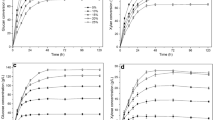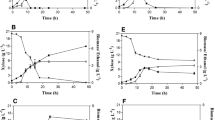Abstract
Dilute-acid softwood hydrolysate, with glucose and xylose as the dominant sugars was fermented to ethanol by co-cultures. The strains used include Saccharomyces cerevisiae 2.535 (1#), Pachysolen tannophilis ATCC 2.1662 (2#), and recombinant Escherichia coli (3#) constructed in our laboratory carrying both pdc and adhB genes derived from Zymomonas mobilis. Before fermentation, the co-cultures were adapted for five batches. Observation under light microscope showed aggregation of adapted strains, which could possibly improve their ability to degrade inhibitors. In addition, we tried to detoxify the dilute-acid softwood hydrolysate with a combined method before fermentation. Our study showed that fermentation of detoxified hydrolysate by adapted co-culture (1# + 2@) generated an exceptionally high ethanol yield on total sugar of 0.49 g/g, corresponding to 96.1% of the maximal theoretical value after 48h; fermentation of detoxified hydrolysate by adapted co-culture (1# + 3#) is faster (24h) and could reach a high ethanol yield (0.45 g/g total sugar). These experiments suggest that both adaptation and detoxification significantly improve hydrolysate fermentation and ethanol production.
Similar content being viewed by others
References
Agblevor, F. A., Fu, J., Hames, B., and McMillan, J. D. (2004) Appl. Biochem. Biotechnol. 199(2) 97–120.
Palmqvist, E. and Hahn-Hagerdal, B. (2000) Biores. Technol. 74, 17–24.
Zaldivar, J., Martinez, A., and Ingram, L. O. (1999) Biotechnol. Bioeng. 65, 24–32.
Mussatto, S. I. and Roberto, I. C. (2004) Biores. Technol. 93, 1–10.
Jönsson, L. J., Palmqvist, E., and Nilvebrant, N. O. (1998) Appl. Microbiol. Biotechnol. 49, 691–697.
Nilvebrant, N. O., Reimann, A., and Larsson, S. (2001) Appl. Biochem. Biotechnol. 91–93, 35–49.
Nigam, J. N. (2002) J. Biotechnol. 97, 107–116.
Miyafuji, H., Danner, H., and Neureiter, M. (2003) Biotechnol. Bioeng 84, 390–393.
Amartey, S. and Jeffries, T. (1996) World J. Microbiol. Biotechnol. 12, 281–283.
Taherzaden, M. J., Millati, R., and Niklasson, C. (2001) Appl. Biochem. Biotechnol. 95, 45–57.
Yamano, L. P., York, S. W., and Ingram, L O. (1998) J. Ind. Microbiol. Biotechnol. 20, 132–138.
Lawford, H. G., Rousseau, J. D., and Mohagheghi, A. (1999) Appl. Biochem. Biotechnol. 77, 191–204.
Rudolf, A., Galbe, M., and Lidén, G. (2004) Appl. Biochem. Biotechnol. 114, 1–3, 601–618.
Author information
Authors and Affiliations
Corresponding author
Rights and permissions
About this article
Cite this article
Qian, M., Tian, S., Li, X. et al. Ethanol production from dilute-acid softwood hydrolysate by co-culture. Appl Biochem Biotechnol 134, 273–283 (2006). https://doi.org/10.1385/ABAB:134:3:273
Received:
Revised:
Accepted:
Issue Date:
DOI: https://doi.org/10.1385/ABAB:134:3:273




